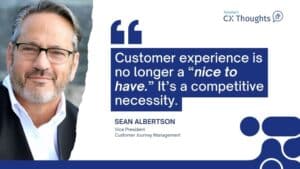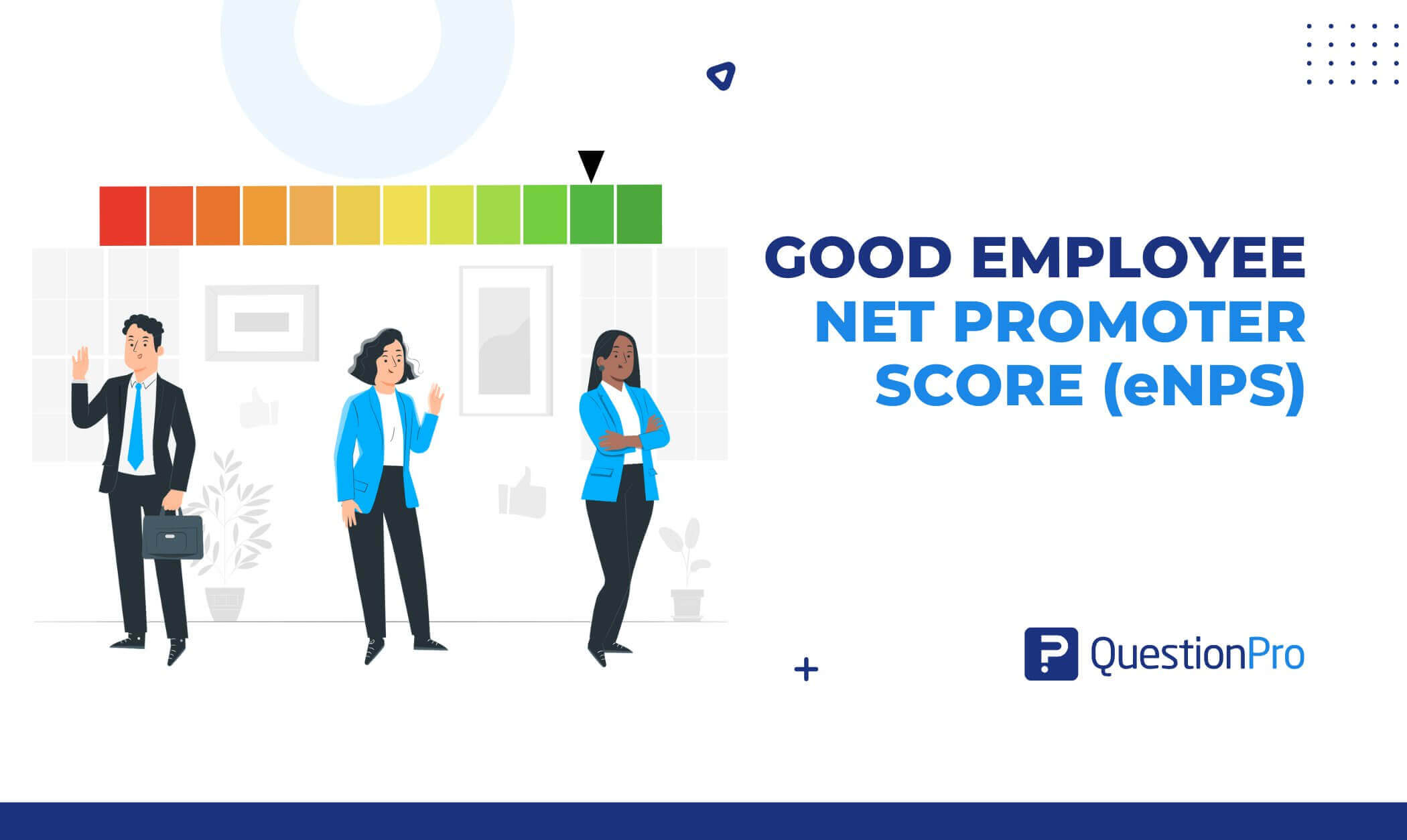
If you’re tracking how your employees feel about your company, the Employee Net Promoter Score (eNPS) is one of the most useful metrics you can use. But once you have the number, the next big question is: What is a good employee NPS?
Understanding what makes a good eNPS score is key to putting your results in context and using them to improve employee satisfaction, loyalty, and engagement.
In this blog, we’ll discuss what different scores mean, how to interpret them, and what actions you can take to measure employee sentiment and actively improve the employee experience.
What is an Employee Net Promoter Score?
The Employee Net Promoter Score (eNPS) is a quick, reliable way to measure how your team feels about your workplace. Based on the Net Promoter Score (NPS) concept originally used to assess customer loyalty, eNPS helps you understand how likely employees are to recommend your company as a great place to work.
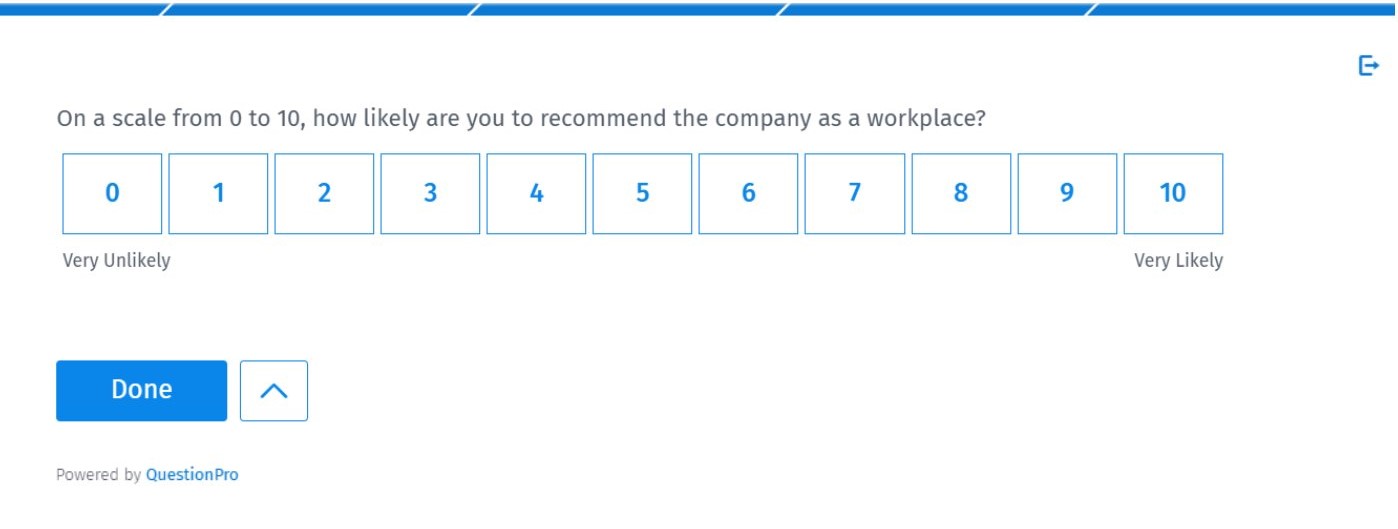
This isn’t just a number, it’s a reflection of employee engagement, employee satisfaction, and employee loyalty. The better your eNPS, the more likely it is that you have enthusiastic employees who feel supported, appreciated, and motivated.
How to Calculate Employee Net Promoter Score (eNPS)?
The formula for calculating eNPS is simple:
eNPS = % of Promoters – % of Detractors
Where:
- Promoters (9–10): Happy, engaged, and loyal employees
- Passives (7–8): Generally satisfied but not actively loyal
- Detractors (0–6): Disengaged employees who may talk negatively or feel disconnected
You’ll end up with a number ranging from – 100 to + 100.
Use our eNPS Score Calculator to measure eNPS to enhance employee loyalty & Advocacy!
What is a Good Employee NPS?
When you measure your employee net promoter score (eNPS), one of the first questions you’ll probably ask is, “Is this score good?” The answer isn’t one-size-fits-all. A good eNPS depends on your company’s industry, size, and region. That said, there are general benchmarks that can help you understand where you stand.
Here’s how to interpret your eNPS results:
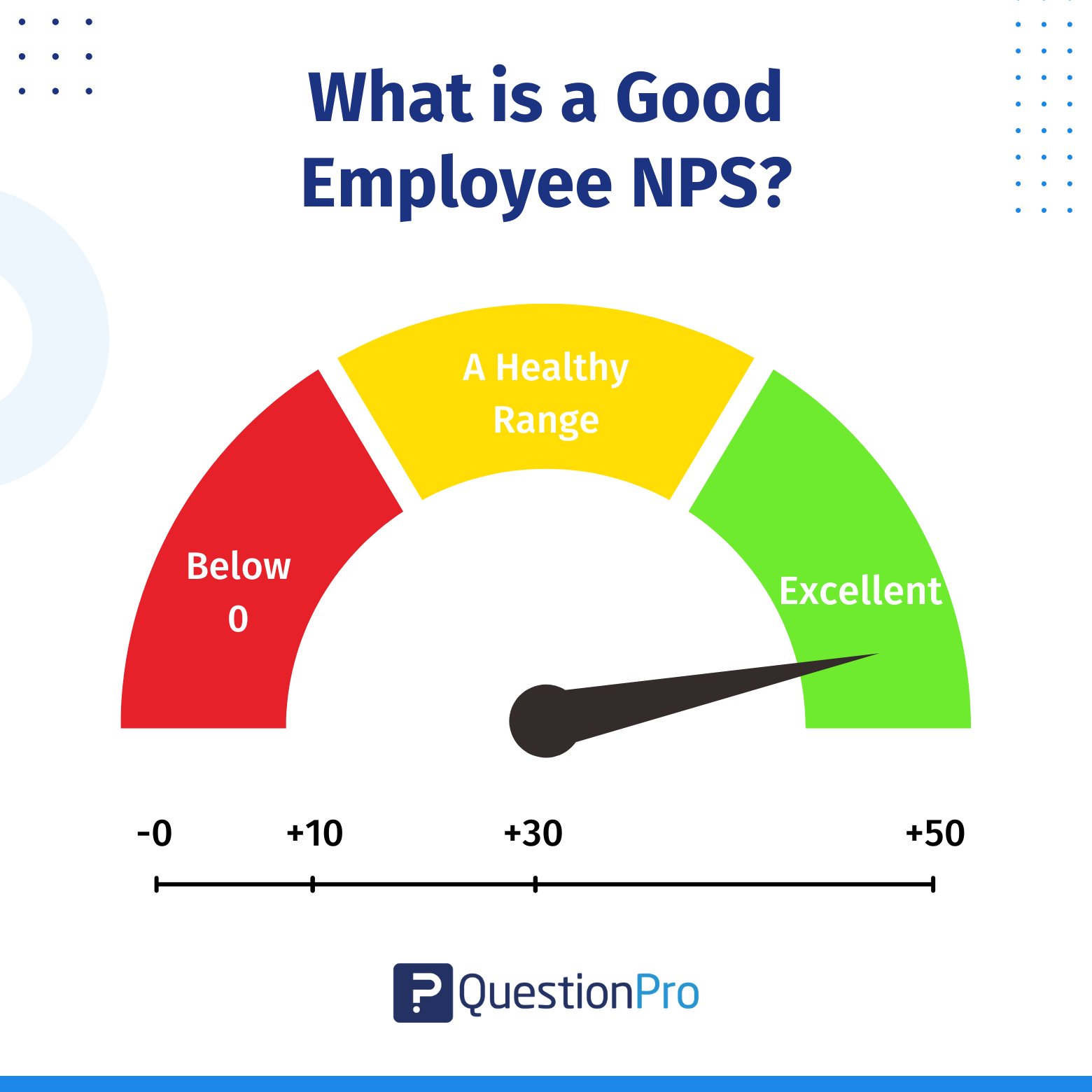
Positive Score (0 and above)
If your score is above 0, it means you have more promoters than detractors—a great start. This suggests that your employees generally feel good about where they work.
+10 to +30: A Healthy Range
This range is considered solid in most industries. It shows that your team is reasonably happy, engaged, and willing to recommend your workplace. You’ve likely created a decent company culture and are doing things right when it comes to employee satisfaction.
+50 and above: Excellent
Now you’re in top-tier territory. A score this high usually means:
- You’ve built a strong employee value proposition
- People feel heard, supported, and motivated
- You invest in development opportunities, work-life balance, and employee feedback
- You’ve got a workforce full of loyal employees and enthusiastic employees who are proud of where they work
Below 0: Time for Action
A negative score signals more detractors than promoters. That’s a red flag. It could mean employees feel disengaged, overlooked, or unhappy. You’ll want to:
- Analyze survey responses
- Gather qualitative feedback
- Look at patterns across teams or departments
- Take immediate action to understand and improve the employee experience
The Real Goal? Progress Over Time
More than hitting a magic number, the most important thing is improvement. Track your company’s eNPS regularly, listen to what employees are saying, and work on making their day-to-day better. A “good” eNPS is one that keeps getting better.
Learn More: Master Your eNPS Insights with QuestionPro Workforce
How to Conduct an eNPS Survey?
Launching an eNPS survey doesn’t require a massive initiative. Here’s how to keep it simple and powerful:
- Ask the eNPS question regularly every quarter or during pulse surveys.
- Always include a follow-up question like “What’s the main reason for your score?” This adds qualitative feedback to your data.
- Make it anonymous to encourage honest, open answers.
- Use segmentation to explore how different employee populations, e.g., departments, locations, and demographics respond.
Pair your eNPS measure with focus groups, one-on-one meetings, and open comment boxes to create a complete picture of how your employees feel.
What is Driving eNPS in Workplaces Today?
To really harness the power of eNPS, you need to go beyond the score. Use it alongside other metrics like:
- Retention rates
- Internal mobility stats
- Performance trends
- Insights from NPS surveys targeting customers
Look at how different employee populations respond, segment by region or department, and analyze qualitative feedback. These layers will give you a complete picture and lead to more actionable insights.
Based on 700,000+ benchmarks, here’s what we know about what improves or drags down net promoter score eNPS:
What’s Working:
- Supportive teams and strong collaboration.
- A sense of purpose and meaningful work.
- Investments in inclusivity and belonging.
- Open communication and positive experiences.
What Needs Work:
- Clunky processes and poor workflow.
- Weak knowledge-sharing across teams.
- Centralized decision-making that excludes those closest to the problem.
- An over-focus on customer loyalty without a balanced employee-first mindset.
eNPS Benchmarks by Industry in 2025
Knowing how your organization’s eNPS stacks up against industry standards can provide valuable insights into employee experience performance. As of 2025, benchmarks specific to various industries have shown notable differences in employee sentiment across different sectors.
We’ve gathered the eNPS scores categorized by industry for you!
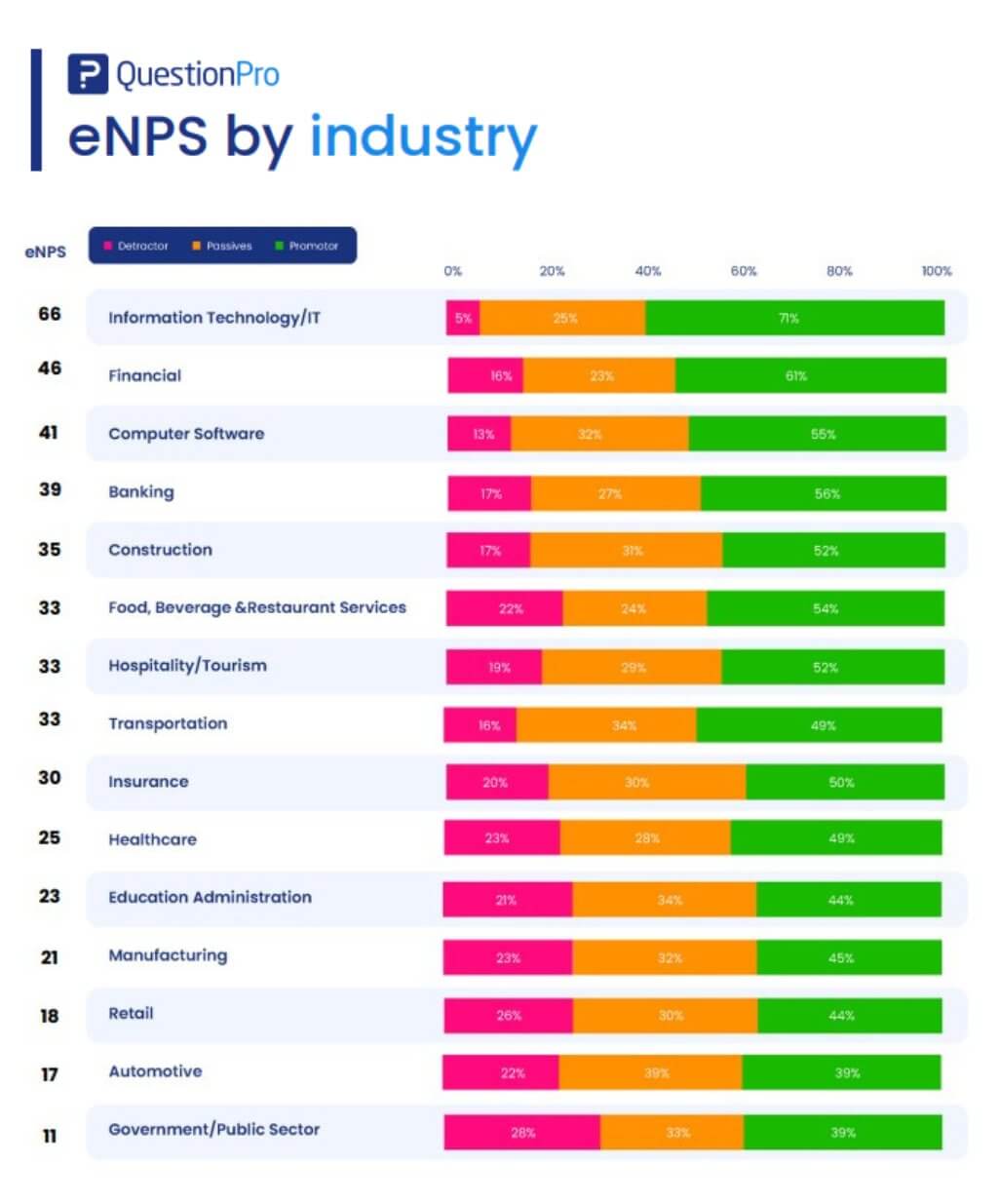
This data comes from QuestionPro’s latest report, which surveyed 5,000 respondents who were employed in full-time positions to measure the Employee Net Promoter Score (eNPS).
Here’s a quick look at the 2025 eNPS scores across different industries, along with how they’ve changed from 2024:
| Industry | eNPS 2025 | eNPS 2024 | YoY Change |
| Information Technology / IT | 66 | 71 | -5 |
| Financial | 46 | 38 | +8 |
| Computer Software | 41 | 43 | -2 |
| Banking | 39 | 43 | -4 |
| Construction | 35 | 48 | -13 |
| Food, Beverage & Restaurant Services | 33 | 6 | +27 |
| Transportation | 33 | 19 | +14 |
| Hospitality / Tourism | 33 | 27 | +6 |
| Insurance | 30 | 38 | -8 |
| Healthcare | 25 | 17 | +8 |
| Education Administration | 23 | 42 | -19 |
| Manufacturing | 21 | 13 | +8 |
| Retail | 18 | 17 | +1 |
| Automotive | 17 | 6 | +11 |
| Government / Public Sector | 11 | 24 | -13 |
| Overall Average | 32 | 25 | +7 |
What are the Benefits of Measuring eNPS?
Here’s what makes eNPS a must-have for any company serious about improving culture and performance:
- Provides insight into how employees feel about their workplace.
- Offers an easy, quick way to gather data without overwhelming your team.
- Helps identify disengagement before it leads to turnover.
- Supports a positive work environment and better company culture.
- Reveals what creates loyal employees and positive experiences.
- Strengthens links between employee engagement and customer loyalty.
In short, it’s one of the most effective tools for understanding and improving the human side of your business.
Potential Drawbacks of Relying on eNPS
While powerful, eNPS isn’t perfect:
- It’s just one question, so it lacks depth without follow-up questions.
- It may not capture the full nuance of employee sentiment.
- If not acted on, it can create negative feedback loops and erode trust.
- Passives, who can swing either way, are often overlooked.
- Cultural differences may skew nps scores across regions.
That’s why eNPS should be part of a broader employee experience strategy, not the only measure you rely on.
How can QuestionPro Help Develop an Employee Net Promoter Score (eNPS)?
Measuring your employee NPS is a great starting point, but making real improvements based on what your employees are telling you is where the real impact happens. That’s exactly where QuestionPro Workforce shines. It’s built to not only help you run eNPS surveys with ease but also to help you act on what you learn.
Here’s how QuestionPro supports every step of your eNPS journey:
- Personalized eNPS Surveys
You can choose from pre-built templates or create your own from scratch. Add your company branding and follow-up questions that get to the “why” behind each score. This means you’re collecting feedback that’s not only easy to understand but deeply insightful.
- Effortless Survey Distribution
Send surveys through email, SMS, or even internal platforms your team already uses. Everything’s mobile-friendly, so employees can respond wherever they are. And with automated reminders and response tracking, you don’t have to worry about chasing people down.
- Live Dashboards and Visual Reports
No spreadsheets. Just clean, real-time dashboards that show you how your company’s eNPS is trending across teams, departments, or locations. It’s simple to spot what’s working and where attention is needed.
- Sync with Your HR Tools
QuestionPro integrates with your existing HR systems, which helps you connect eNPS data with things like turnover rates, performance trends, and engagement scores. This gives you a much clearer picture of your overall employee experience.
- Turn Feedback into Action
The best part? You can actually do something with the feedback. Whether it’s launching a pulse survey, following up with specific teams, or tracking progress over time, QuestionPro helps you move from data to decisions.
Conclusion
A good eNPS score means more than just employee loyalty. It reflects the strength of your company culture, your leadership, and your ability to foster a positive work environment.
Whether you’re a startup or a large enterprise, using eNPS to collect employee feedback, take immediate action, and build on what’s working will help you attract and retain the best people.
Your employees are your most valuable asset. So when they say they’d recommend you as a great place to work, listen. That’s the real power of eNPS.
Frequently Asked Questions (FAQ’s)
Answer: Anything above +10 is a strong start. If you hit +30 or higher, that shows a healthy, motivated team. The average eNPS varies by industry, so always compare with similar organizations.
Answer: Quarterly or twice a year works well. Combine it with pulse surveys for real-time feedback without survey fatigue.
Answer: Yes, when paired with other metrics like exit interviews or performance data. Low eNPS and high negative feedback often signal disengagement and potential turnover risk.
Answer: Act on feedback, focus on communication, recognition, and involve teams in the improvement process.
Answer: Yes, it builds trust and shows that feedback leads to real action.






